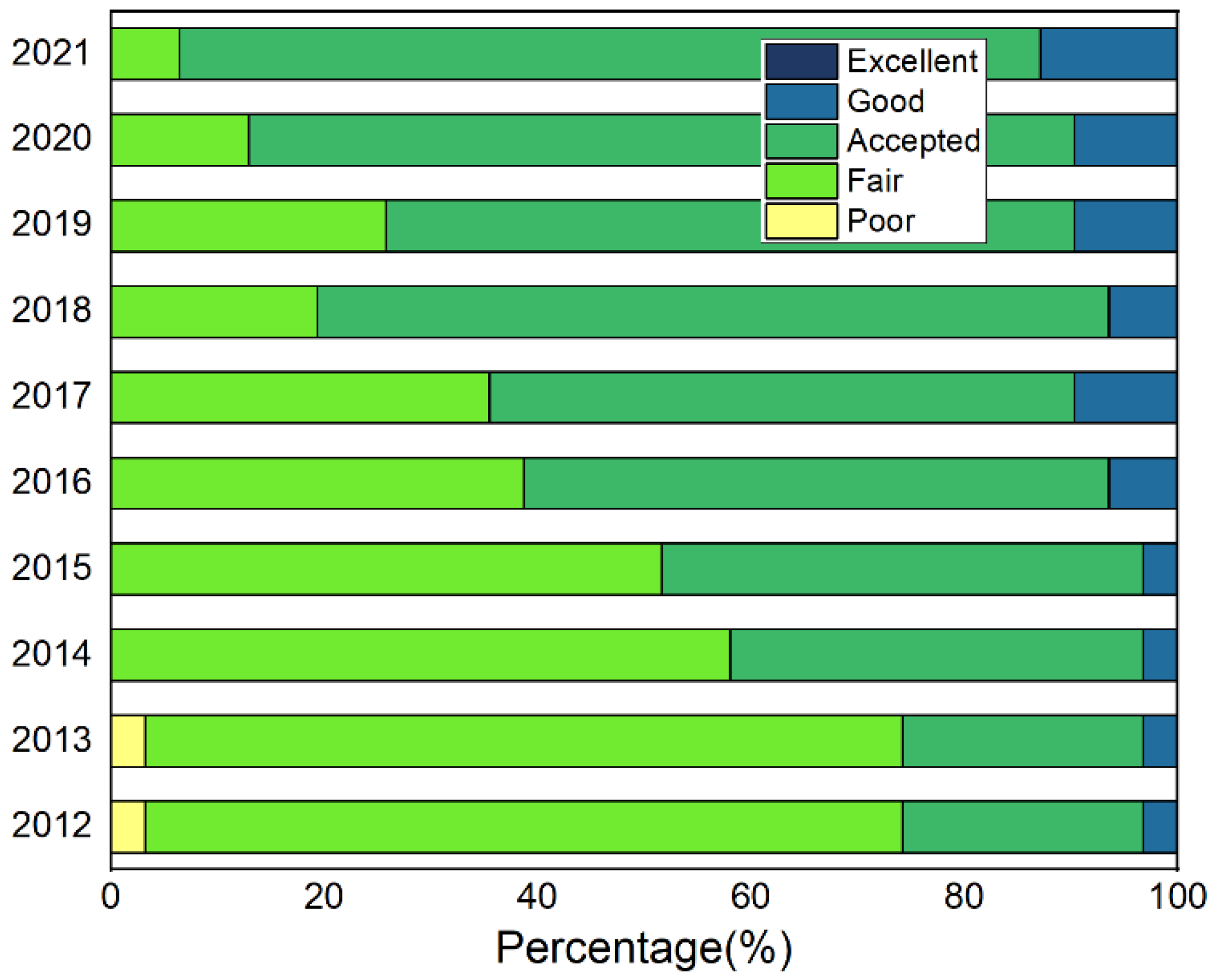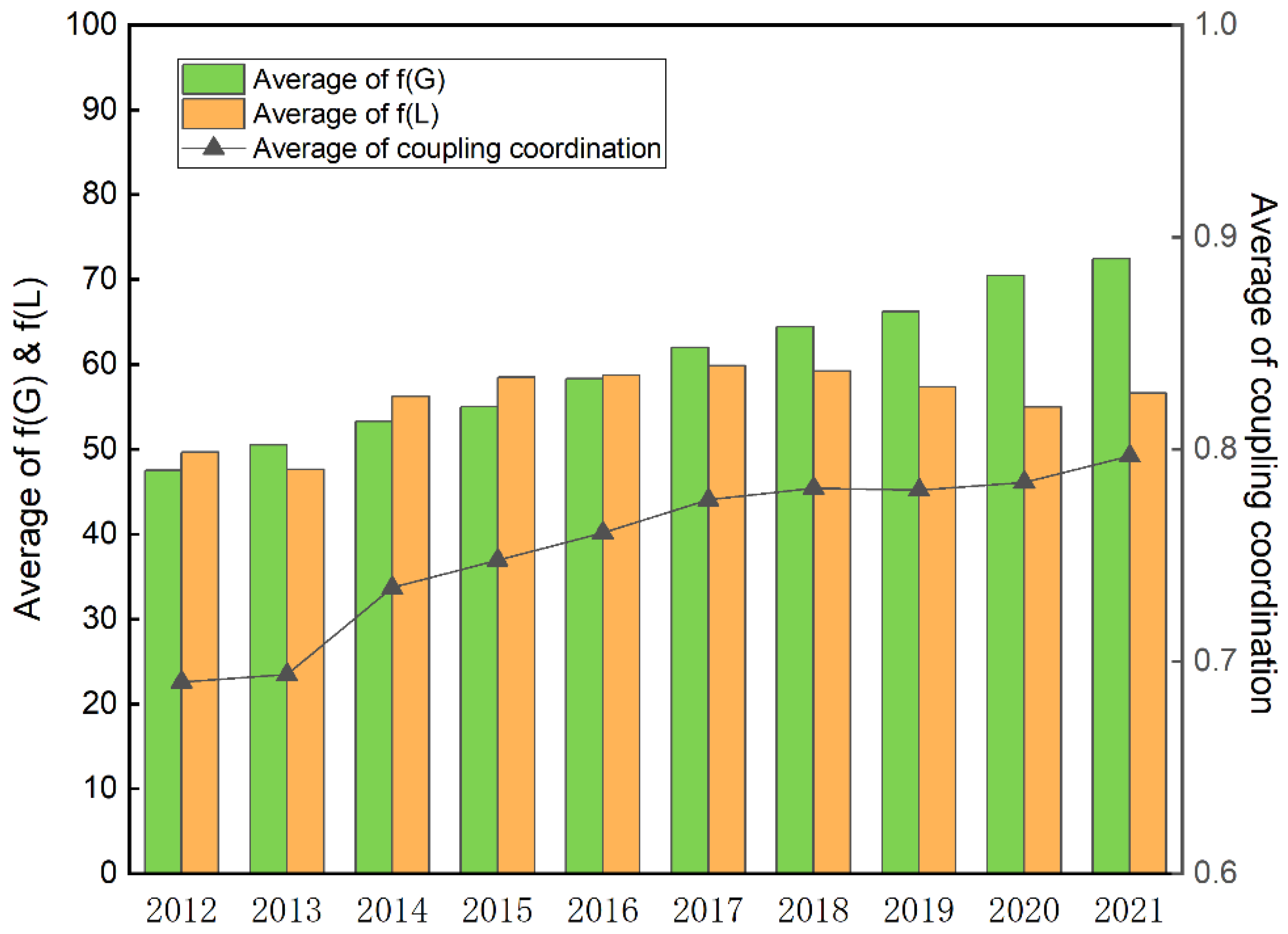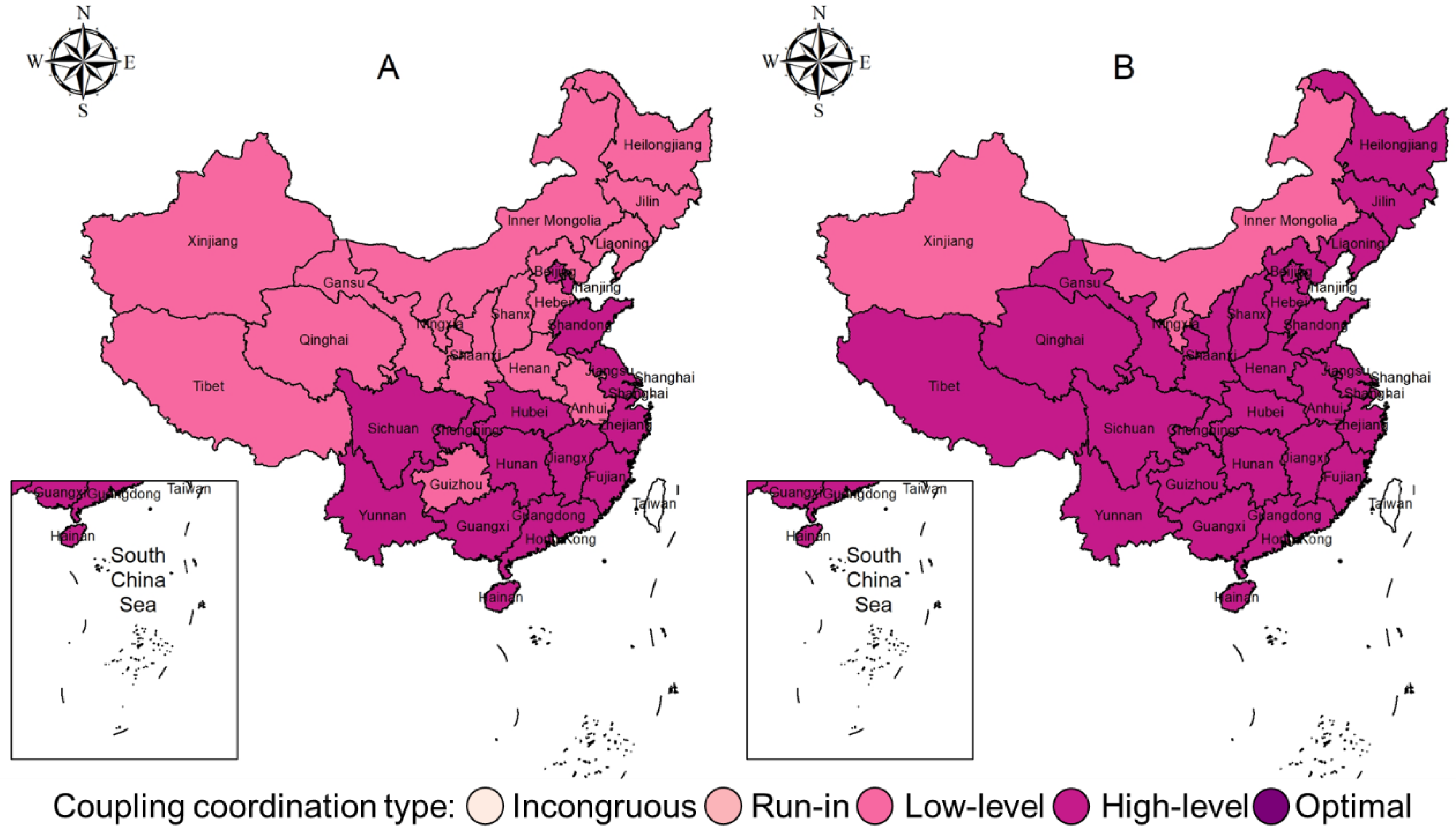Evaluation of Green and Low-Carbon Development Level of Chinese Provinces Based on Sustainable Development Goals
Abstract
:1. Introduction
2. Method and Data
2.1. Measurement System
2.2. Method
2.2.1. Thresholds for Indicators
2.2.2. Data Standardization
2.2.3. The Weights of Indicators
2.2.4. The Index of Green and Low-Carbon Development
2.2.5. Data Sources
2.3. Coupling Coordination Analysis
3. Results and Discussion
3.1. Assessment of Overall Green and Low-Carbon Development Levels in China’s Provincial Areas
3.2. Spatial and Temporal Analysis of Green and Low-Carbon Development Levels
3.3. Coupling Coordination Results
4. Conclusions and Discussion
4.1. Conclusions
4.2. Implications
4.3. Limitation and Future Research
Supplementary Materials
Author Contributions
Funding
Institutional Review Board Statement
Informed Consent Statement
Data Availability Statement
Acknowledgments
Conflicts of Interest
References
- Chen, X.; Chen, Z. Can Green Finance Development Reduce Carbon Emissions? Empirical Evidence from 30 Chinese Provinces. Sustainability 2021, 13, 12137. [Google Scholar] [CrossRef]
- Cai, X.; Wang, W.; Rao, A.; Rahim, S.; Zhao, X. Regional Sustainable Development and Spatial Effects From the Perspective of Renewable Energy. Front. Environ. Sci. 2022, 10, 859523. [Google Scholar] [CrossRef]
- Belmonte-Ureña, L.J.; Plaza-Úbeda, J.A.; Vazquez-Brust, D.; Yakovleva, N. Circular economy, degrowth and green growth as pathways for research on sustainable development goals: A global analysis and future agenda. Ecol. Econ. 2021, 185, 107050. [Google Scholar] [CrossRef]
- Lin, B.Q.; Ma, R.Y. Green technology technology innovations, urban innovation environment and CO2 emission reduction in China: Fresh evidence from a partially linear functional-coefficient panel model. Technol. Forecast. Soc. Chang. 2022, 176, 121434. [Google Scholar] [CrossRef]
- Chen, J.; Gao, M.; Cheng, S.; Liu, X.; Hou, W.; Song, M.; Li, D.; Fan, W. China’s city-level carbon emissions during 1992–2017 based on the inter-calibration of nighttime light data. Sci. Rep. 2021, 11, 3323. [Google Scholar] [CrossRef]
- Sun, Y.P.; Guan, W.; Cao, Y.; Bao, Q. Role of green finance policy in renewable energy deployment for carbon Evidence from China. Renew. Energy 2022, 197, 643–653. [Google Scholar] [CrossRef]
- Zhang, M.L.; Liu, Y. Influence of digital finance and green technology innovation on China’s carbon emission efficiency: Empirical analysis based on spatial metrology. Sci. Total Environ. 2022, 838, 156463. [Google Scholar] [CrossRef]
- Rasoulinezhad, E.; Taghizadeh-Hesary, F. Role of green finance in improving energy efficiency and renewable energy development. Energy Effic. 2022, 15, 14. [Google Scholar] [CrossRef]
- Cheng, Z.H.; Li, L.S.; Liu, J. Industrial structure, technical progress and carbon intensity in China’s provinces. Renew. Sustain. Energy Rev. 2018, 81, 2935–2946. [Google Scholar] [CrossRef]
- Yang, T.; Zhou, K.L.; Zhang, C. Spatiotemporal patterns and influencing factors of green development efficiency in China?s urban agglomerations. Sustain. Cities Soc. 2022, 85, 104069. [Google Scholar] [CrossRef]
- Cheng, J.H.; Yi, J.; Dai, S.; Xiong, Y. Can low-carbon city construction facilitate green growth? Evidence from China’s pilot low-carbon city initiative. J. Clean. Prod. 2019, 231, 1158–1170. [Google Scholar] [CrossRef]
- Sun, C.H. How are green finance, carbon emissions, and energy resources related in Asian sub-regions? Resour. Policy 2023, 83, 103648. [Google Scholar] [CrossRef]
- Wu, H.T.; Li, Y.; Hao, Y.; Ren, S.; Zhang, P. Environmental decentralization, local government competition, and regional green development: Evidence from China. Sci. Total Environ. 2020, 708, 135085. [Google Scholar] [CrossRef]
- Du, K.R.; Cheng, Y.Y.; Yao, X. Environmental regulation, green technology innovation, and industrial structure upgrading: The road to the green transformation of Chinese cities. Energy Econ. 2021, 98, 105247. [Google Scholar] [CrossRef]
- Qiu, S.L.; Wang, Z.L.; Liu, S. The policy outcomes of low-carbon city construction on urban green development: Evidence from a quasi-natural experiment conducted in China. Sustain. Cities Soc. 2021, 66, 102699. [Google Scholar] [CrossRef]
- Dong, F.; Zhu, J.; Li, Y.; Chen, Y.; Gao, Y.; Hu, M.; Qin, C.; Sun, J. How green technology innovation affects carbon emission efficiency: Evidence from developed countries proposing carbon neutrality targets. Environ. Sci. Pollut. Res. 2022, 29, 35780–35799. [Google Scholar] [CrossRef]
- Zhu, B.Z.; Zhang, M.; Zhou, Y.; Wang, P.; Sheng, J.; He, K.; Wei, Y.-M.; Xie, R. Exploring the effect of industrial structure adjustment on interprovincial green development efficiency in China: A novel integrated approach. Energy Policy 2019, 134, 110946. [Google Scholar] [CrossRef]
- Shao, J.; Wang, L.H. Can new-type urbanization improve the green total factor energy efficiency? Evidence from China. Energy 2023, 262, 125499. [Google Scholar] [CrossRef]
- Chen, X.; Xing, L.; Zhou, J.; Wang, K.; Lu, J.; Han, X. Spatial and temporal evolution and driving factors of county solid waste harmless disposal capacity in China. Front. Environ. Sci. 2023, 10, 1056054. [Google Scholar] [CrossRef]
- Ko, S.; Kim, W.; Shin, S.-C.; Shin, J. The economic value of sustainable recycling and waste management policies: The case of a waste management crisis in South Korea. Waste Manag. 2020, 104, 220–227. [Google Scholar] [CrossRef]
- Sun, W.; Huang, C.C. How does urbanization affect carbon emission efficiency? Evidence from China. J. Clean. Prod. 2020, 272, 122828. [Google Scholar] [CrossRef]
- Yin, X.L.; Xu, Z.R. An empirical analysis of the coupling and coordinative development of China’s green finance and economic growth. Resour. Policy 2022, 75, 102476. [Google Scholar] [CrossRef]
- Zhou, X.G.; Tang, X.M.; Zhang, R. Impact of green finance on economic development and environmental quality: A study based on provincial panel data from China. Environ. Sci. Pollut. Res. 2020, 27, 19915–19932. [Google Scholar] [CrossRef] [PubMed]
- Guo, Y.H.; Tong, L.J.; Mei, L. The effect of industrial agglomeration on green development efficiency in Northeast China since the revitalization. J. Clean. Prod. 2020, 258, 120584. [Google Scholar] [CrossRef]
- Zhang, J.N.; Lyu, Y.; Li, Y.; Geng, Y. Digital economy: An innovation driving factor for low-carbon development. Environ. Impact Assess. Rev. 2022, 96, 106821. [Google Scholar] [CrossRef]
- Zhang, H.Y.; Gao, S.Z.; Zhou, P. Role of digitalization in energy storage technological innovation: Evidence from China. Renew. Sustain. Energy Rev. 2023, 171, 113014. [Google Scholar] [CrossRef]
- Wang, J.; Dong, K.; Dong, X.; Taghizadeh-Hesary, F. Assessing the digital economy and its carbon-mitigation effects: The case of China. Energy Econ. 2022, 113, 106198. [Google Scholar] [CrossRef]
- Zhao, X.X.; Zheng, M.B.; Fu, Q. How natural disasters affect energy innovation? The perspective of environmental sustainability. Energy Econ. 2022, 109, 105992. [Google Scholar] [CrossRef]
- Geddes, A.; Schmidt, T.S.; Steffen, B. The multiple roles of state investment banks in low-carbon energy finance: An analysis of Australia, the UK and Germany. Energy Policy 2018, 115, 158–170. [Google Scholar] [CrossRef]
- Caputo, F.; Garcia-Perez, A.; Cillo, V.; Giacosa, E. A knowledge-based view of people and technology: Directions for a value co-creation-based learning organisation. J. Knowl. Manag. 2019, 23, 1314–1334. [Google Scholar] [CrossRef]
- Li, L.; Li, G.; Ozturk, I.; Ullah, S. Green innovation and environmental sustainability: Do clean energy investment and education matter? Energy Environ. 2022, 34, 2705–2720. [Google Scholar] [CrossRef]
- Jiakui, C.; Abbas, J.; Najam, H.; Liu, J.; Abbas, J. Green technological innovation, green finance, and financial development and their role in green total factor productivity: Empirical insights from China. J. Clean. Prod. 2023, 382, 135131. [Google Scholar] [CrossRef]
- Imran, M.; Jian, Z.; Haque, A.U.; Urbański, M.; Nair, S.L.S. Determinants of Firm’s Export Performance in China’s Automobile Industry. Sustainability 2018, 10, 4078. [Google Scholar] [CrossRef]
- Shao, J.; He, Z.W. How does social media drive corporate carbon disclosure? Evidence from China. Front. Ecol. Evol. 2022, 10, 971077. [Google Scholar] [CrossRef]
- Li, X.S.; Shu, Y.X.; Jin, X. Environmental regulation, carbon emissions and green total factor productivity: A case study of China. Environ. Dev. Sustain. 2022, 24, 2577–2597. [Google Scholar] [CrossRef]
- Xu, Z.C.; Chau, S.N.; Chen, X.; Zhang, J.; Li, Y.; Dietz, T.; Wang, J.; Winkler, J.A.; Fan, F.; Huang, B.; et al. Assessing progress towards sustainable development over space and time. Nature 2020, 577, 74–78. [Google Scholar] [CrossRef]
- Nerini, F.F.; Sovacool, B.; Hughes, N.; Cozzi, L.; Cosgrave, E.; Howells, M.; Tavoni, M.; Tomei, J.; Zerriffi, H.; Milligan, B. Connecting climate action with other Sustainable Development Goals. Nat. Sustain. 2019, 2, 674–680. [Google Scholar] [CrossRef]
- Wang, J.B.; Xue, Y.F.; Han, M.Y. Impact of carbon emission price and natural resources development on the green economic recovery: Fresh insights from China. Resour. Policy 2023, 81, 103255. [Google Scholar] [CrossRef]
- Wang, J.L.; Wang, W.; Ran, Q.; Irfan, M.; Ren, S.; Yang, X.; Wu, H.; Ahmad, M. Analysis of the mechanism of the impact of internet development on green economic growth: Evidence from 269 prefecture cities in China. Environ. Sci. Pollut. Res. 2022, 29, 9990–10004. [Google Scholar] [CrossRef] [PubMed]
- Tang, Z. An integrated approach to evaluating the coupling coordination between tourism and the environment. Tour. Manag. 2015, 46, 11–19. [Google Scholar] [CrossRef]
- Liu, N.N.; Liu, C.; Xia, Y.; Da, B. Examining the coordination between urbanization and eco-environment using coupling and spatial analyses: A case study in China. Ecol. Indic. 2018, 93, 1163–1175. [Google Scholar] [CrossRef]
- Yang, C.; Zeng, W.; Yang, X. Coupling coordination evaluation and sustainable development pattern of geo-ecological environment and urbanization in Chongqing municipality, China. Sustain. Cities Soc. 2020, 61, 102271. [Google Scholar] [CrossRef]
- Lee, C.C.; Lee, C.C. How does green finance affect green total factor productivity? Evidence from China. Energy Econ. 2022, 107, 105863. [Google Scholar] [CrossRef]
- Pan, X.F.; Li, M.; Wang, M.; Chu, J.; Bo, H. The effects of outward foreign direct investment and reverse technology spillover on China’s carbon productivity. Energy Policy 2020, 145, 111730. [Google Scholar] [CrossRef]
- Fang, Z.M.; Kong, X.; Sensoy, A.; Cui, X.; Cheng, F. Government’s awareness of Environmental protection and corporate green innovation: A natural experiment from the new environmental protection law in China. Econ. Anal. Policy 2021, 70, 294–312. [Google Scholar] [CrossRef]
- Gao, X.W.; Liu, N.; Hua, Y.J. Environmental Protection Tax Law on the synergy of pollution reduction and carbon reduction in China: Evidence from a panel data of 107 cities. Sustain. Prod. Consum. 2022, 33, 425–437. [Google Scholar] [CrossRef]
- Zeng, B.; Zeng, M.; Xue, S.; Cheng, M.; Wang, Y.; Feng, J. Overall review of wind power development in Inner Mongolia: Status quo, barriers and solutions. Renew. Sustain. Energy Rev. 2014, 29, 614–624. [Google Scholar] [CrossRef]
- Rehman, A.; Ma, H.; Chishti, M.Z.; Ozturk, I.; Irfan, M.; Ahmad, M. Asymmetric investigation to track the effect of urbanization, energy utilization, fossil fuel energy and CO2 emission on economic efficiency in China: Another outlook. Environ. Sci. Pollut. Res. 2021, 28, 17319–17330. [Google Scholar] [CrossRef]






| Dimension | Indicator | Weight | Type |
|---|---|---|---|
| Life and consumption | Engel’s coefficient | 0.0146031 | O |
| Domestic electricity use per capita | 0.0097941 | L | |
| Daily domestic water use per capita | 0.0140664 | G | |
| Area of parkland per capita | 0.0287866 | G | |
| CO2 emissions per capita | 0.0172428 | L | |
| Public transportation passengers per capita | 0.0419623 | L | |
| Development power | GDP per capita | 0.0277562 | O |
| Urbanization rate | 0.019945 | O | |
| Disposable income per capita | 0.0336448 | O | |
| Share of non-fossil energy in primary energy consumption | 0.0895867 | L | |
| Share of renewable energy in total electricity generation | 0.0637569 | L | |
| Water consumption per 10,000 yuan GDP | 0.0148017 | G | |
| Energy consumption per 10,000 yuan GDP | 0.0177554 | L | |
| Energy consumption elasticity coefficient | 0.0502642 | L | |
| Construction land area per capita | 0.0189288 | O | |
| Value added of tertiary sector as a share of GDP | 0.0281711 | O | |
| Patents per 10,000 people | 0.0993802 | O | |
| R&D share of GDP | 0.0410256 | O | |
| Ecology environment | PM2.5 concentration | 0.0218065 | G |
| Proportion of good waters | 0.0267063 | G | |
| Forest cover | 0.0212723 | G | |
| Wetland protection rate | 0.020639 | G | |
| Ecological quality index | 0.0212645 | G | |
| Greening coverage of built-up area | 0.0179714 | G | |
| Governance capabilities | Centralized sewage treatment rate | 0.0143161 | G |
| Recycled water utilization rate | 0.0405179 | G | |
| Non-hazardous treatment rate of domestic waste | 0.0148262 | G | |
| The comprehensive utilization rate of general industrial solid waste | 0.0357899 | O | |
| Energy saving and environmental protection guarantee capacity | 0.0245373 | O | |
| CO2 emissions per unit of GDP | 0.0127008 | L | |
| NOx emissions per unit of GDP | 0.0132064 | G | |
| SO2 emissions per unit of GDP | 0.0159366 | G | |
| Number of buses for 10,000 people | 0.0211027 | L | |
| Length of public transportation routes for 10,000 people | 0.0459342 | L |
| Situations | Selection Method |
|---|---|
| Referencing absolute values |
| Select recognized ideal values |
| Using the average of the top 5% data for this indicator |
| GLD Value Interval | Stage Type |
|---|---|
| 0 ≤ GLD < 20 | Poor |
| 20 ≤ GLD < 40 | Fair |
| 40 ≤ GLD < 60 | Accepted |
| 60 ≤ GLD < 80 | Good |
| 80 ≤ GLD ≤ 100 | Excellent |
| D Value | Coupling Coordination Type |
|---|---|
| 0 ≤ D < 0.3 | Incongruous |
| 0.3 ≤ D < 0.5 | Run-in |
| 0.5 ≤ D < 0.7 | Low level |
| 0.7 ≤ D < 0.9 | High level |
| 0.9 ≤ D ≤ 1.0 | Optimal |
Disclaimer/Publisher’s Note: The statements, opinions and data contained in all publications are solely those of the individual author(s) and contributor(s) and not of MDPI and/or the editor(s). MDPI and/or the editor(s) disclaim responsibility for any injury to people or property resulting from any ideas, methods, instructions or products referred to in the content. |
© 2023 by the authors. Licensee MDPI, Basel, Switzerland. This article is an open access article distributed under the terms and conditions of the Creative Commons Attribution (CC BY) license (https://creativecommons.org/licenses/by/4.0/).
Share and Cite
Lu, Z.; Shao, C.; Wang, F.; Dong, R. Evaluation of Green and Low-Carbon Development Level of Chinese Provinces Based on Sustainable Development Goals. Sustainability 2023, 15, 15449. https://doi.org/10.3390/su152115449
Lu Z, Shao C, Wang F, Dong R. Evaluation of Green and Low-Carbon Development Level of Chinese Provinces Based on Sustainable Development Goals. Sustainability. 2023; 15(21):15449. https://doi.org/10.3390/su152115449
Chicago/Turabian StyleLu, Zhirui, Chaofeng Shao, Fang Wang, and Ruiyu Dong. 2023. "Evaluation of Green and Low-Carbon Development Level of Chinese Provinces Based on Sustainable Development Goals" Sustainability 15, no. 21: 15449. https://doi.org/10.3390/su152115449





